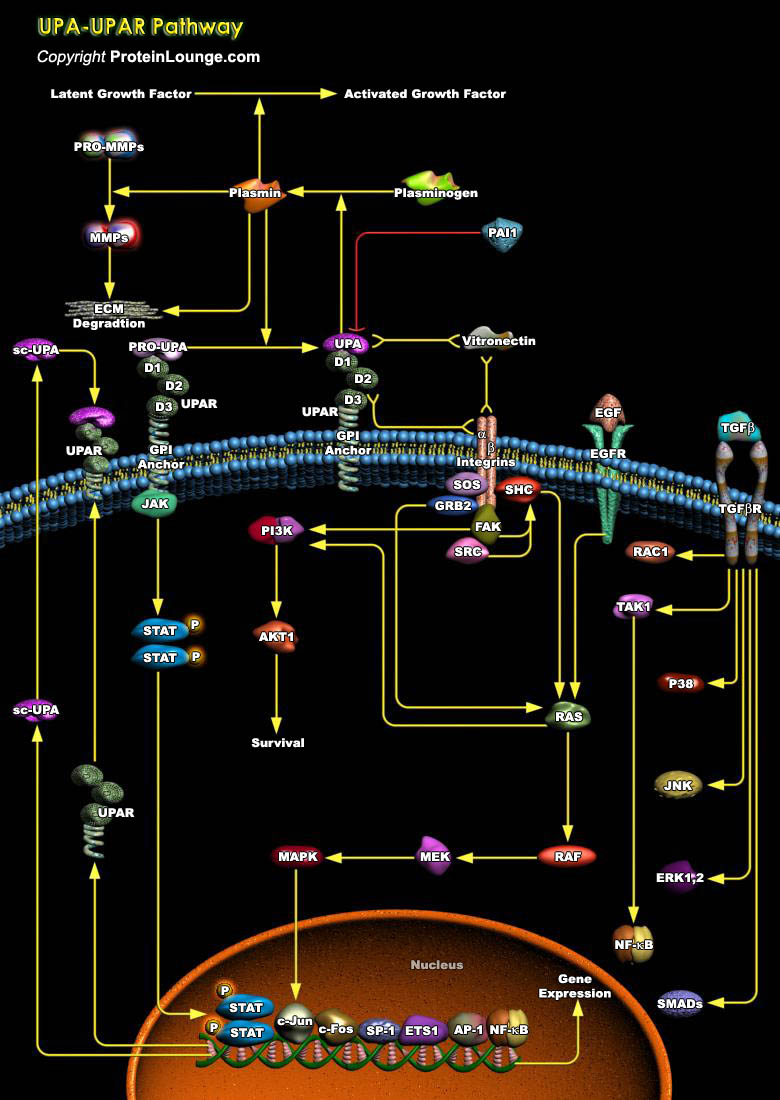
Proteases are expressed by normal cells in tissue remodeling events and also during pathological events such as tumor invasion and metastasis. Some of the proteases including serine proteinases and MMPs (Metalloproteinases) have been implicated in remodeling of the ECM (Extracellular Matrix) in lung injury and lung neoplasia. These enzymes influence inflammatory cell traffic or cancer cell invasiveness via the breakdown of basement membranes and ECM. Plasmin, a serine protease, is involved in the dissolution of ECM and basement membrane during tissue degradation. This protease is generated via the action of plasminogen activators such as Urokinase (UPA, Urokinase-type Plasminogen Activator) or Urokinase (tissue Plasminogen Activator) and can influence tissue remodeling[..]
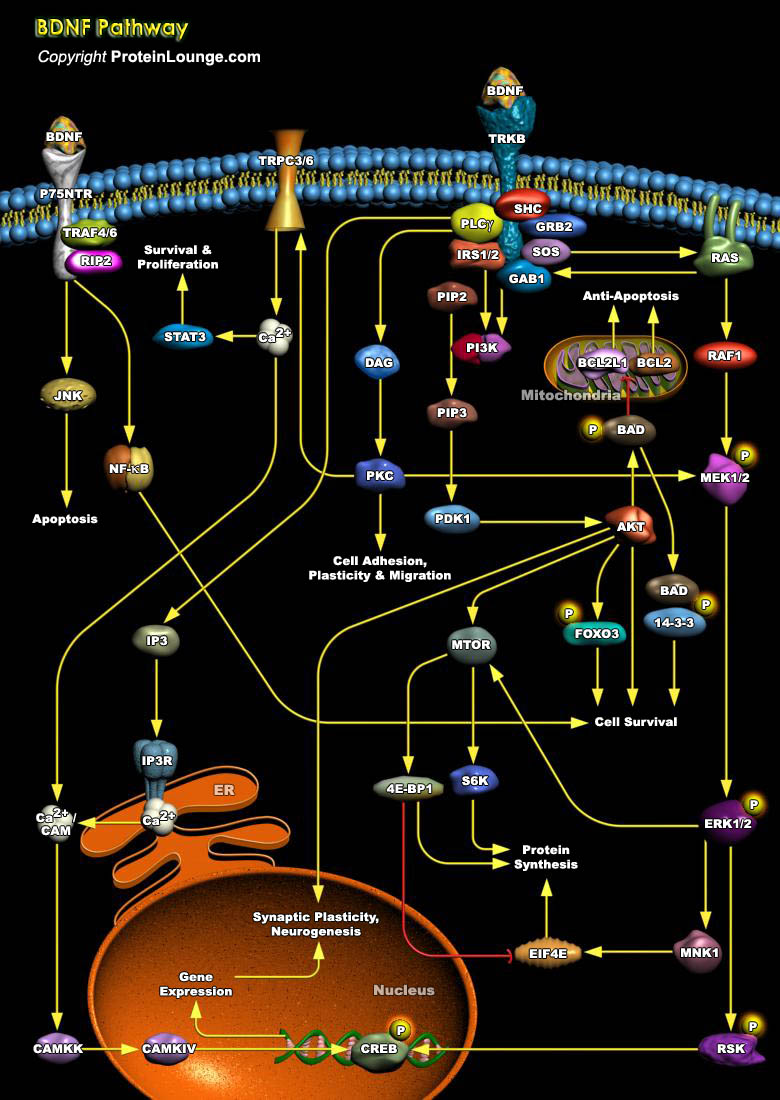
Neurotrophins are an important class of signaling molecules in the brain responsible for axon targeting, neuron growth, maturation of synapses during development, and synaptic plasticity. This family of molecules includes NGF (Nerve Growth Factor), BDNF (Brain Derived Neurotrophic Factor), NT3 (Neurotrophin-3) and NT4 (Neurotrophin-4) [Ref.1].Brain-derived neurotrophic factor (BDNF) is one of the neurotrophic factors that support differentiation, maturation, and survival of neurons in the nervous system and shows a neuroprotective effect under adverse conditions, such as glutamatergic stimulation, cerebral ischemia, hypoglycemia, and neurotoxicity. BDNF stimulates and controls growth of new neurons from neural stem cells (neurogenesis) and BDNF protein and mRNA have[..]
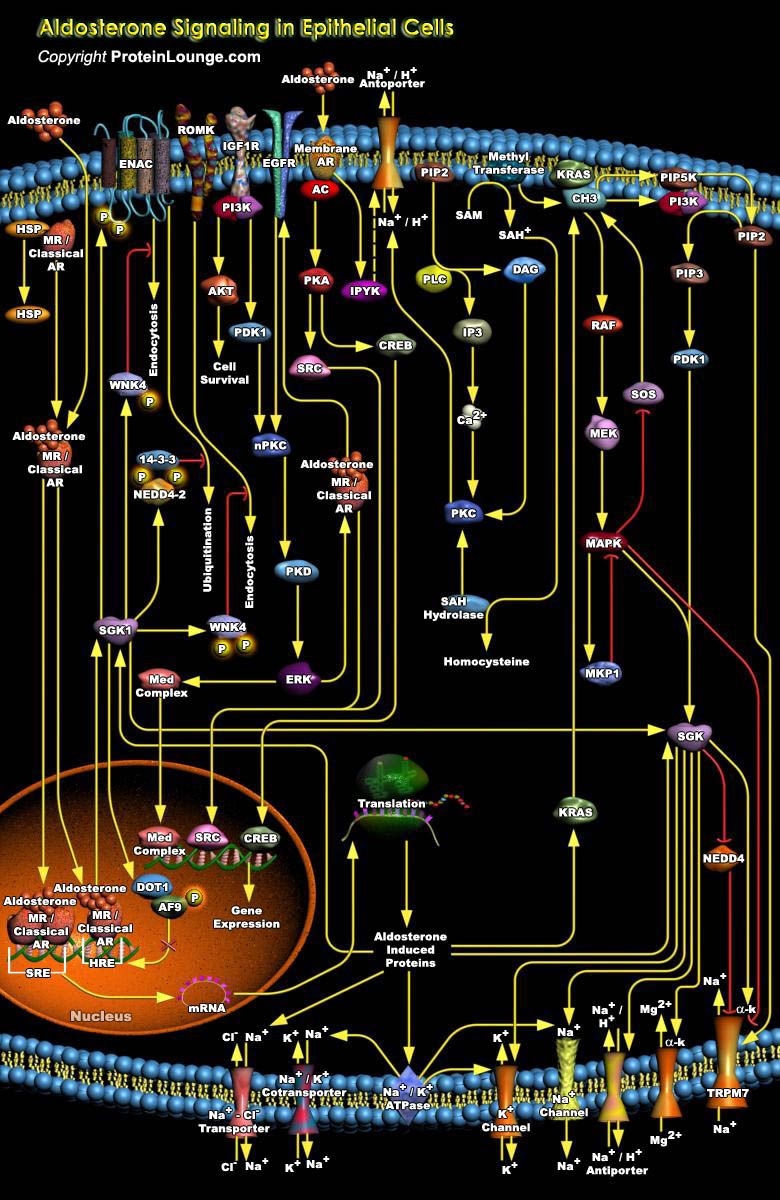
Sodium transport across the tight epithelia of Na+ reabsorbing tissues such as the distal nephron and colon is the major factor determining total body Na+ levels, and thus, long term blood pressure. Aldosterone, a steroid hormone that is primarily produced in the outer layer of the adrenal cortex, maintains total organism sodium balance in all higher vertebrates. Principally, in humans, aldosterone is involved in the regulation of electrolyte and water balance through its effects on ion transport in epithelial cells. Electrically tight epithelial monolayers, such as the renal distal tubule and collecting duct system, distal colon, and those in salivary glands, are considered classic aldosterone target tissues. Aldosterone plays a major role in Na+, K+, and H+[..]
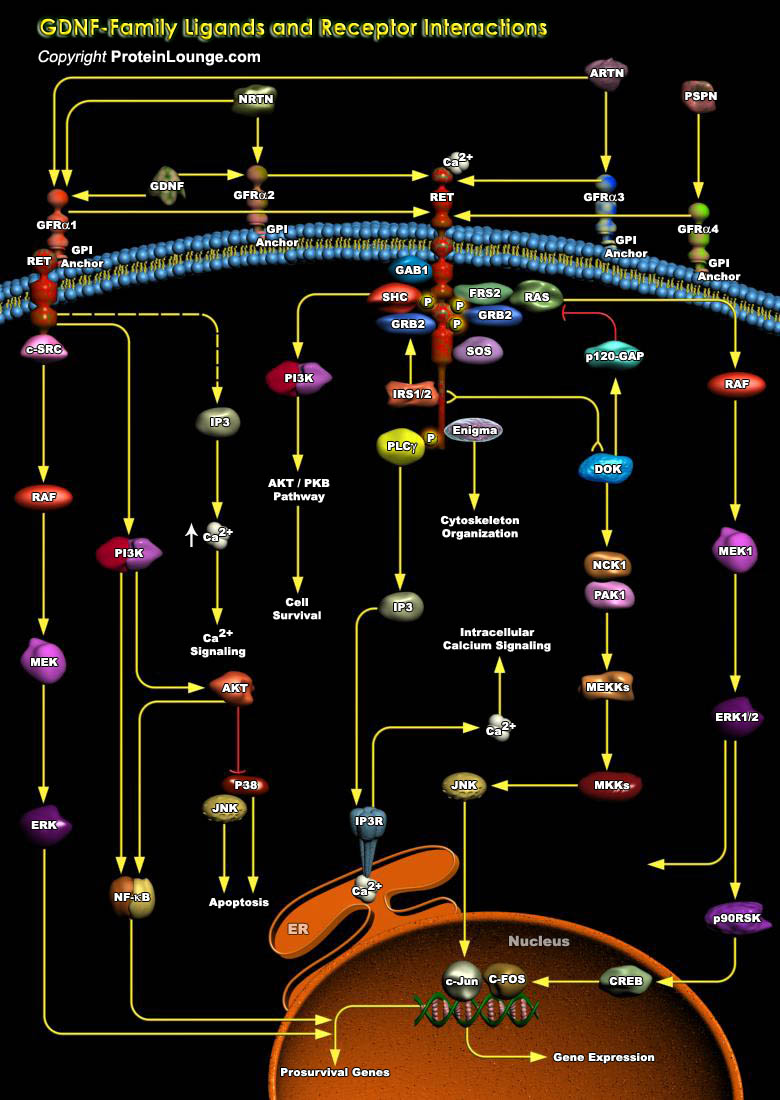
Neurotrophic factors are a broad set of peptide growth factors that tightly regulate many critical aspects of the ontogeny of neurons, such as the number of neurons in a given population, neurite branching and synaptogenesis, adult synaptic plasticity and maturation of electrophysiological properties. Neurotrophic factors include Neurotrophins, Neurokines and GDNF (Glial-cell-line-derived Neurotrophic Factor) family ligands (GFLs). GDNF family, consisting of GDNF, NRTN (Neurturin), ARTN (Artemin) and PSPN (Persephin) are distant members of the TGF-Beta (Transforming Growth Factor-Beta) superfamily that maintain several neuronal populations in the CNS (Central Nervous Systems), including midbrain dopamine neurons. In addition, GDNF, NRTN and ARTN support the survival[..]
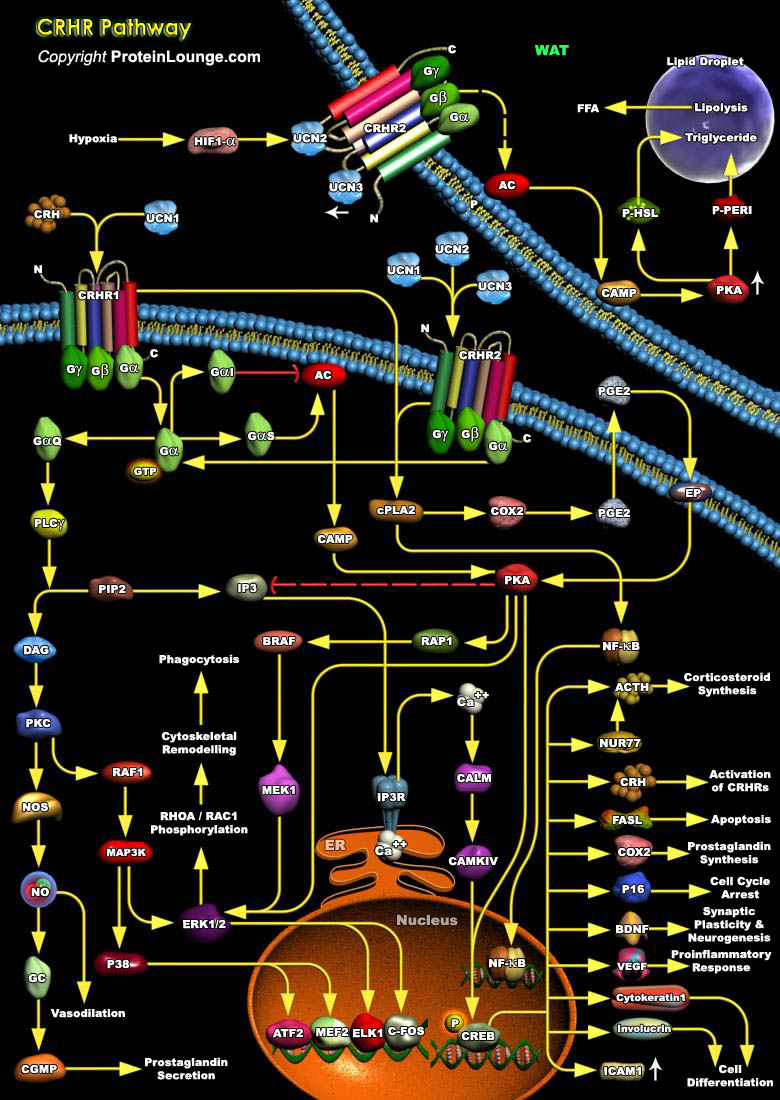
CRH (Corticotropin-Releasing Hormone) and related peptides play a major role in coordinating the behavioral, endocrine, cardiovascular, autonomic and immune mechanisms that allow mammals to adapt under both basal and stressful conditions. Their actions are mediated through activation of two types of GPCRs (G-Protein-Coupled Receptors): CRHR1 (CRH Receptor-1) and CRHR2 (CRH Receptor-2) encoded by separate genes. CRH and CRH-related peptides and their receptors are widely distributed in the central nervous system, and in a variety of peripheral tissues, including the immune, cardiovascular and reproductive systems, adrenals, lungs, liver, stomach, pancreas, small intestine, skin tissues, and also in some types of human tumors. The ubiquitous distribution of CRH-related[..]
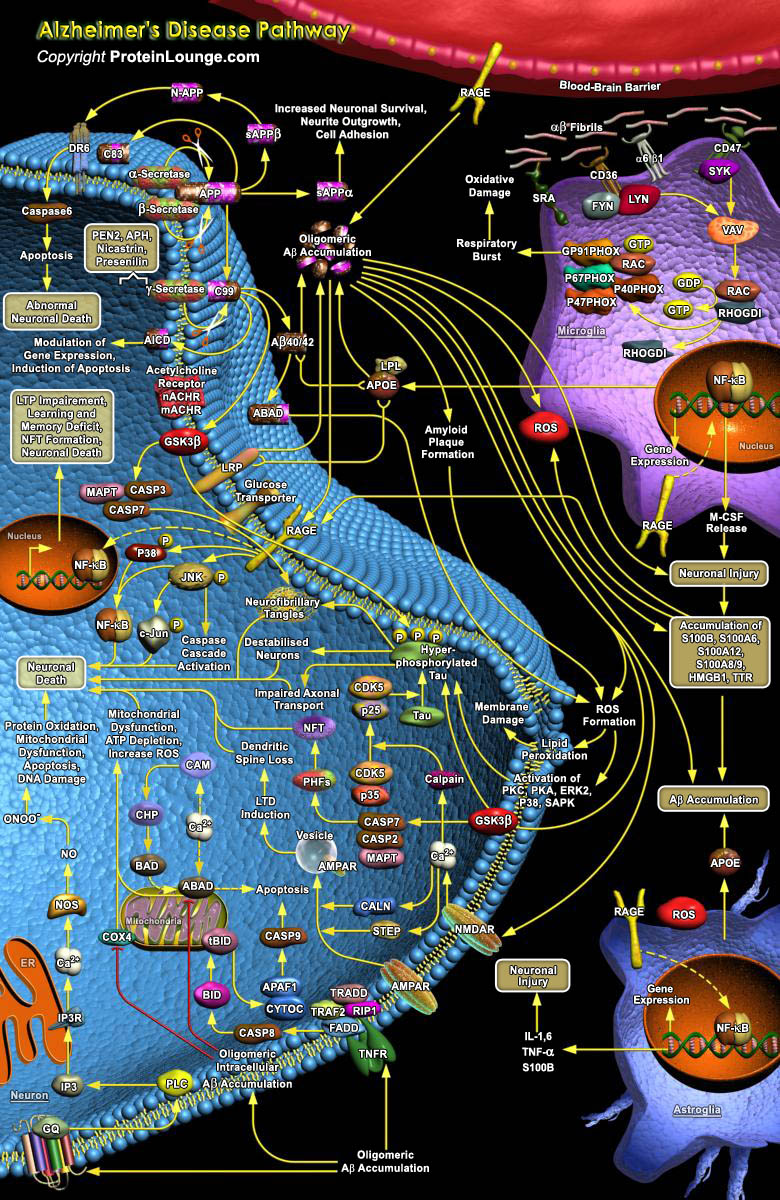
AD (Alzheimer's Disease) is a neurodegenerative disorder leading to amnesia, cognitive impairment, and senile dementia. Two types of lesions characterize the disease: SPs (Amyloid or Senile Plaques) resulting from the extracellular aggregation of ABeta (Amyloid Beta) peptide, which is derived from a ubiquitous type I transmembrane protein named APP (Amyloid Precursor Protein), and NFTs (Neuro-Fibrillary Tangles) composed of intraneuronal bundles of PHF (Paired Helical Filaments). PHF result from the aggregation of pathologic Tau proteins, named PHF-Tau1. Both lesions extend progressively to neocortical brain areas during the course of Alzheimer Disease. The link between Amyloid deposits and NFTs is not yet clear. The vast majority of cases of Alzheimer Disease are[..]
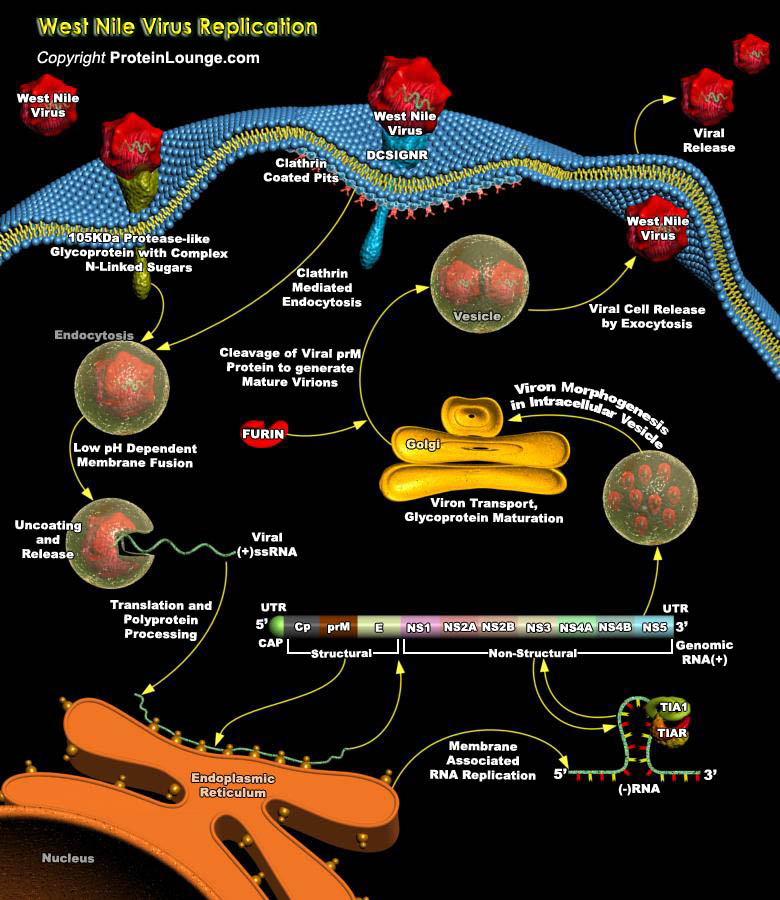
WNV (West Nile Virus) is a single-stranded positive-polarity enveloped virus with icosahedral symmetry virus and the etiologic agent of West Nile encephalitis. It is a member of the Japanese encephalitis virus antigenic group within the family Flaviviridae, which can cause fatal encephalitis associated with damage to the CNS (Central Nervous System) in humans and animals. Wild birds are the natural reservoir (amplifying) hosts, and WNV transmission cycle primarily involving Culex sp mosquitoes. Initially isolated in 1937, it is now recognized as one of the most widely distributed flaviviruses, endemic in Africa, Europe, the Middle East, and parts of Asia. Since 1999, the virus has been recognized in North America by causing an epizootic among birds and horses[..]
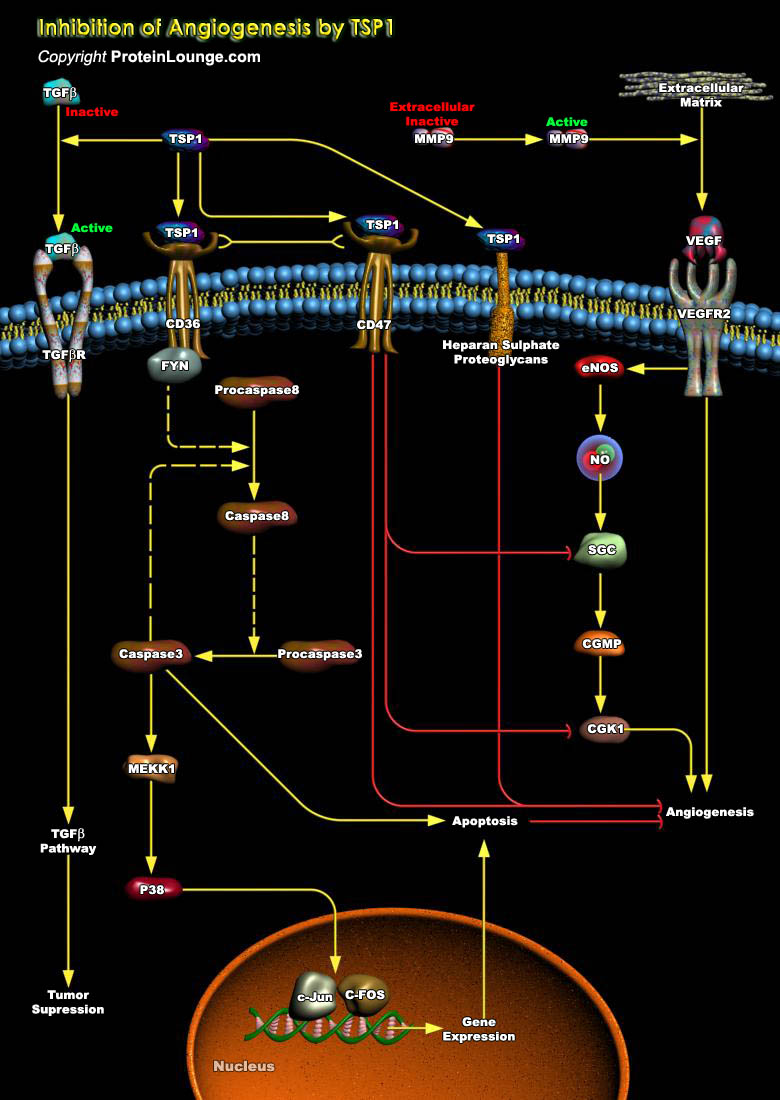
Cancer is a multistep process that includes deregulation of cell cycle, transformation, invasion of stroma, angiogenesis and metastasis. Angiogenesis is an essential component for tumor development regulated by both proangiogenic and antiangiogenic factors (Ref.1). It is a multi-step process that includes endothelial cell proliferation, migration, basement membrane degradation, and new lumen organization. Naturally occurring inhibitors of angiogenesis i.e., antiangiogenic factors are found in mammalian tissues, where they help maintain the quiescence of the normal vasculature. Thus, angiogenic inhibitors have been considered as potential anticancer drugs. TSP1 (Thrombospondin-1) is a naturally occurring inhibitor of angiogenesis that limits vessel density in normal[..]
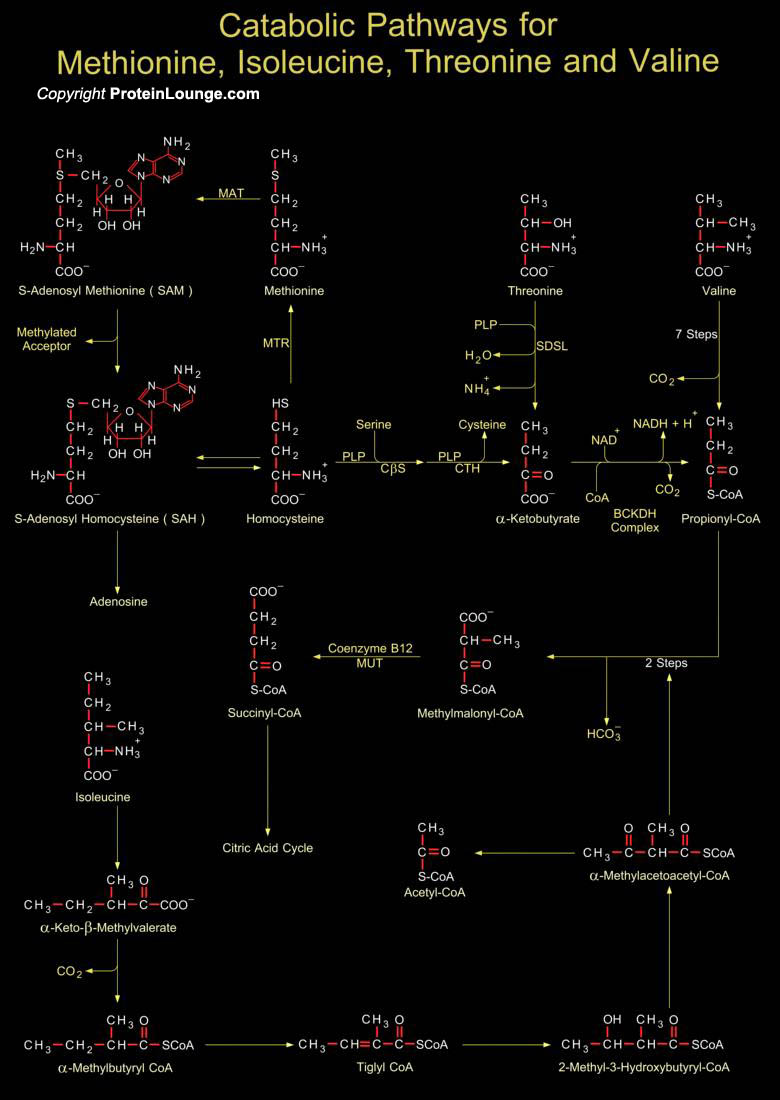
The carbon skeletons of Methionine, Isoleucine, Threonine and Valine are degraded by pathways that yield Succinyl-CoA (Succinyl-Coenzyme A), an intermediate of the Citric Acid Cycle. Methionine donates its Methyl group to one of several possible acceptors through S-adenosylmethionine and three of its four remaining carbon atoms are converted to the Propionate of Propionyl-CoA, a precursor of Succinyl-CoA. Isoleucine undergoes transamination, followed by oxidative decarboxylation of the resulting Alpha-Keto Acid. The remaining five-carbon skeleton is further oxidized to Acetyl-CoA and Propionyl-CoA (Ref. 3). Valine undergoes transamination and decarboxylation and then a series of oxidation reactions convert the remaining four carbons to Propionyl-CoA (Ref.1). In[..]
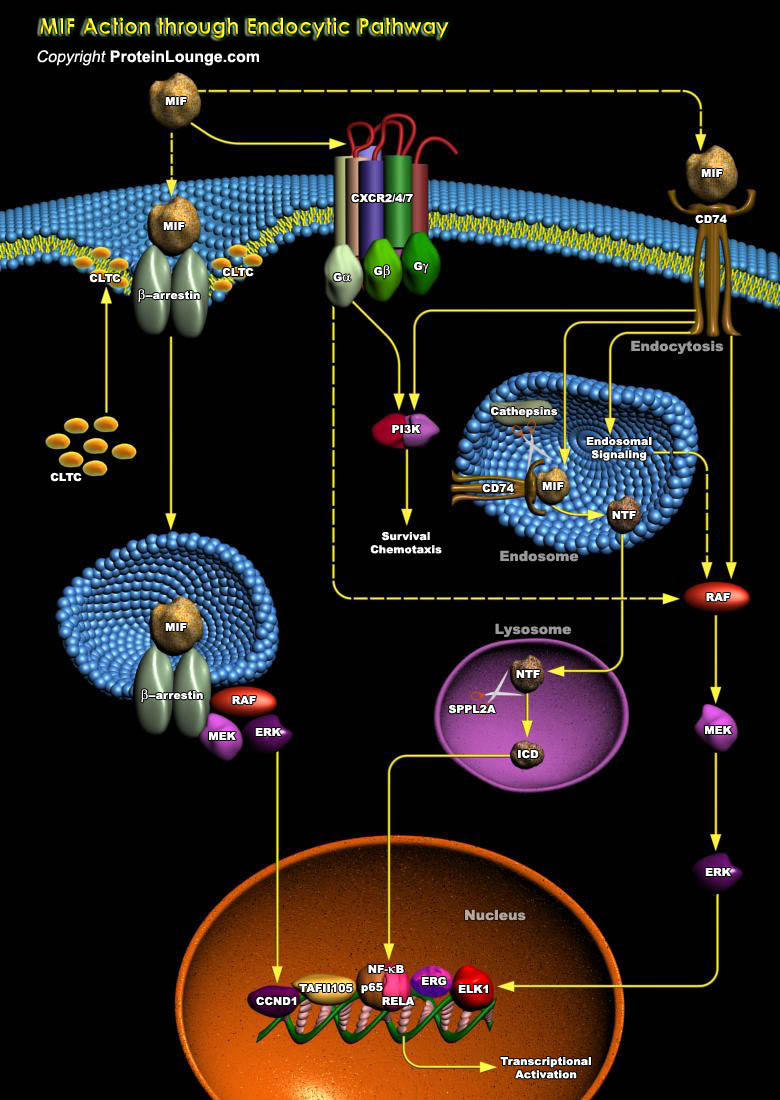
The cytokine MIF (Macrophage Migration Inhibitory Factor) is an integral mediator of the innate immune system. Monocytes and macrophages constitutively express large amounts of MIF, which is rapidly released after exposure to bacterial toxins and cytokines. MIF exerts potent proinflammatory activities and is an important cytokine of septic shock. MIF regulates innate immune responses to endotoxin and gram-negative bacteria by modulating the expression of TLR4 (Toll-Like Receptor-4), the signal-transducing molecule of the LPS (Lipopolysaccharide) receptor complex (Ref.1). Cells may take up MIF by endocytosis — a process by which a cell's outer membrane engulfs extracellular substances (often in a nonspecific way) and imports them into the cell in[..]
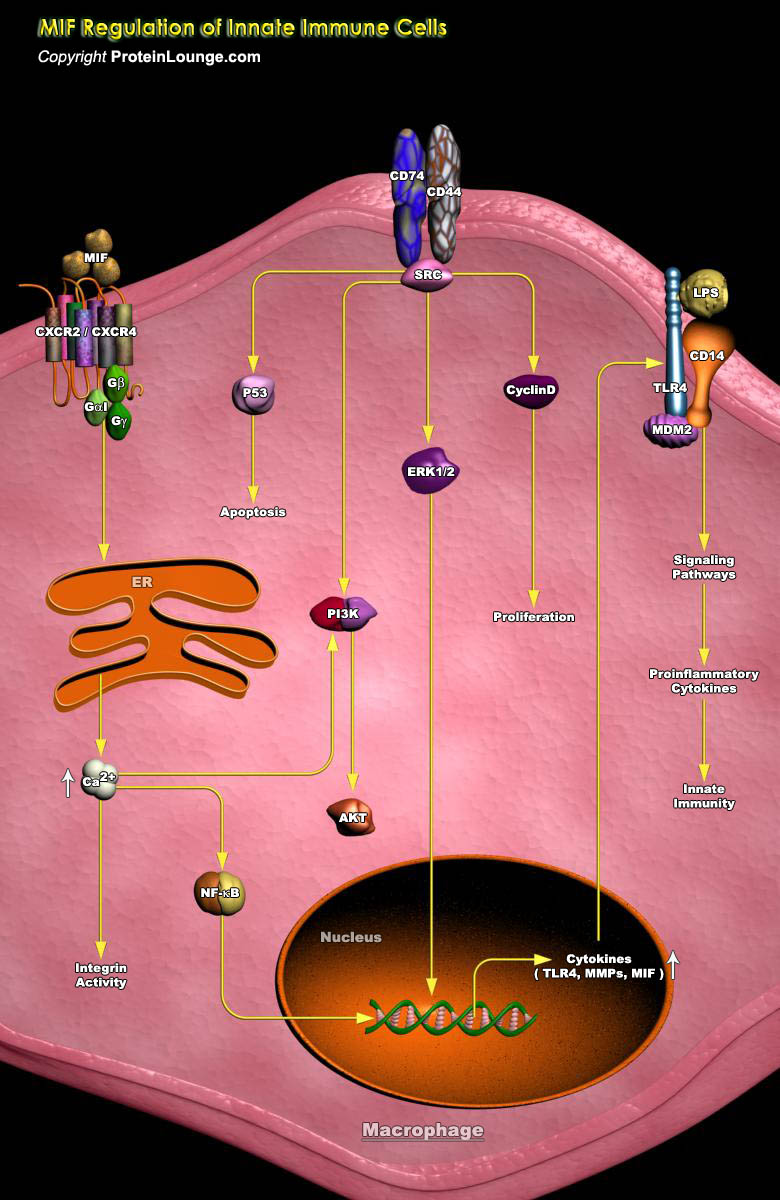
The innate immune response to bacteria is essential for survival but the systemic release of inflammatory mediators results in the life-threatening Septic-shock reaction. Macrophages are essential effector cells of innate immunity that play a pivotal role in the recognition and elimination of invasive microorganisms. Mediators released by activated macrophages orchestrate innate and adaptive immune host responses. The cytokine MIF (Macrophage Migration Inhibitory Factor) is an integral mediator of the innate immune system. Monocytes and macrophages constitutively express large amounts of MIF, which is rapidly released after exposure to bacterial toxins and cytokines. MIF exerts potent proinflammatory activities and is an important cytokine of septic shock. MIF[..]
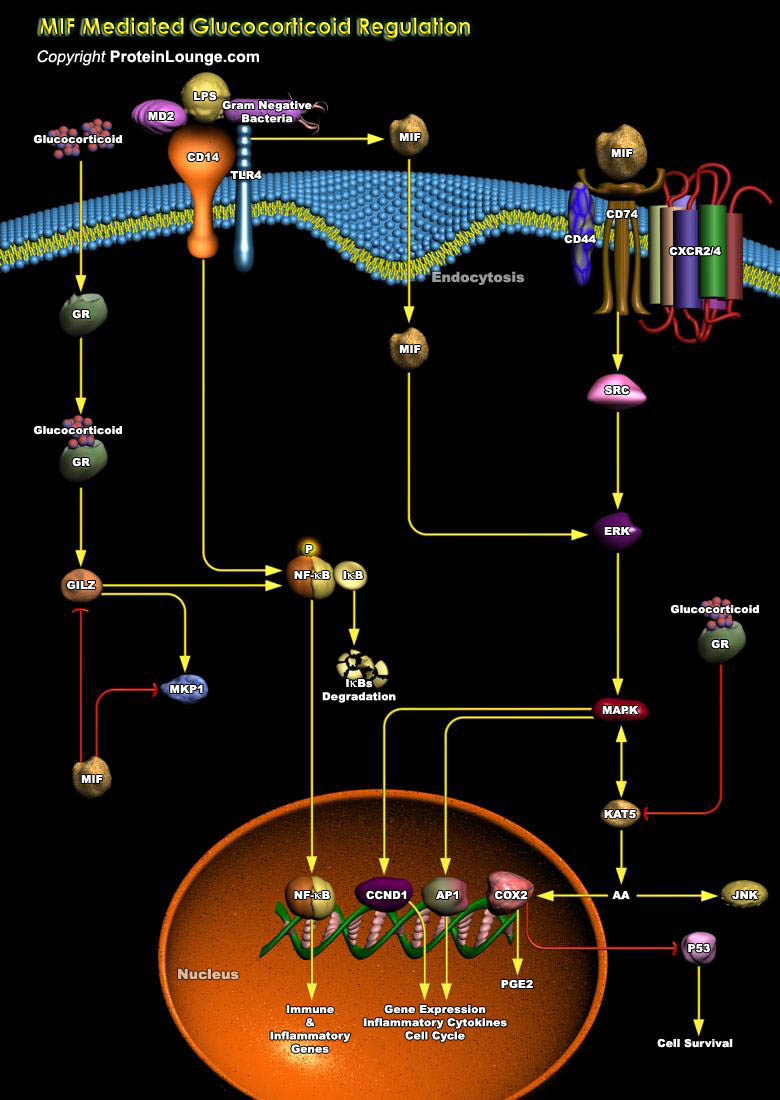
Glucocorticoids are among the most potent anti-inflammatory and immunosuppressive agents. They inhibit synthesis of almost all known cytokines, enzymes involved in the inflammatory process and of several cell surface molecules required for immune function. Glucocorticoids mediate these effects through an intracellular receptor, the GR (Glucocorticoid Receptor), a member of the steroid/thyroid hormone receptor super family. The Glucocorticoid hormones affect the metabolism of carbohydrates, proteins, and lipids in a manner nearly opposite to that of insulin and influence a wide variety of other vital functions, including nucleic acid synthesis, maintenance of blood pressure, inflammatory reactions and the capacity to cope with stress. Data presently indicates that[..]

